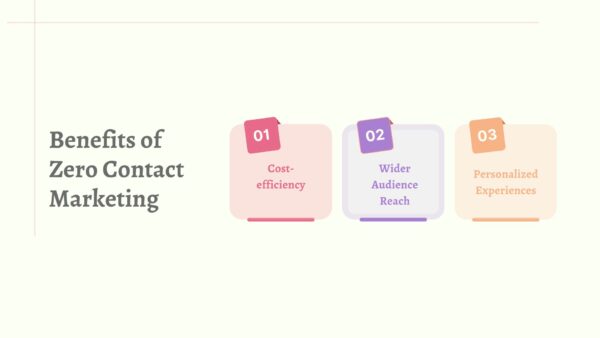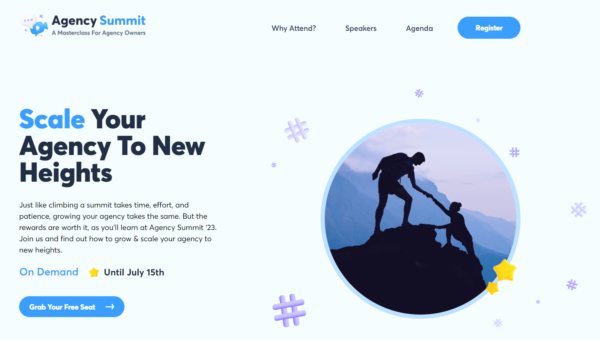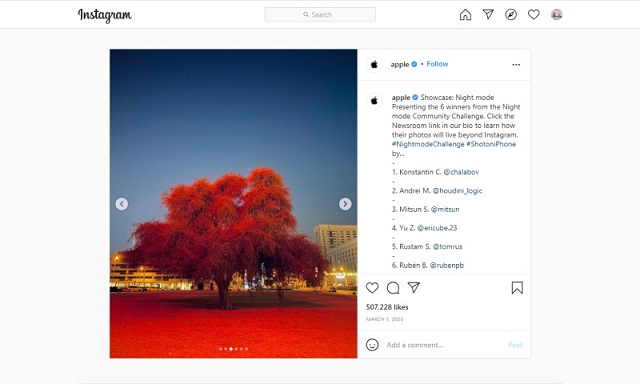What is Zero Contact Marketing? Everything You Need To Know
Summary
15 Best SaaS Marketing Blogs You Should Follow in 2024
Establishing strong bonds with your customers stands as the paramount strategy for achieving success. Consequently, an increasing number of businesses from various niches, aspire to maintain a close connection with their customer base. Nevertheless, maintaining physical contact with customers at all times is an impractical approach.
Therefore, businesses must constantly turn to innovative marketing tactics to remain relevant in the market and outpace competitors. Among these tactics, Zero Contact Marketing emerges as a highly effective approach. Nearly 90% of marketing firms are already prioritizing the acquisition of zero-contact data within a year, underscoring its effectiveness.
This marketing strategy emphasizes on connecting and engaging customers without any use of direct or physical interaction. In this article, we will learn about the Zero-Contact marketing strategy, what are the benefits of using it, and how you can leverage it to engage and convert more customers.
So, let’s dive in!
What is Zero Contact Marketing?
Zero Contact Marketing is a marketing strategy that aims to attract and connect with customers without requiring the use of any physical contact. It involves utilizing digital channels, offering personalized solutions, and leveraging automation to reach the targeted customers wherever they are.
Such a method ensures that you are connected with your audience without having to be available face-to-face or involve any physical touch points.
Benefits of Zero Contact Marketing
As we understood, Zero Contact Marketing allows you to be in touch with your customers digitally, here’s how you can benefit from it:

1. Cost-efficiency
By utilizing digital channels and automation, Zero Contact Marketing automatically eliminates the cost of traditional marketing. You do not need to invest in any expensive methods like print advertising or physical events. This significant cost reduction gives you the opportunity to invest in other areas of growth and business improvement.
2. Wider Audience Reach
With the Zero Contact Marketing strategy, you can reach audiences beyond your physical location. You can now diminish geographical barriers that were stopping to connect yourself globally. No matter where your business is, this strategy helps you gain broader access to global markets and diverse demographics.
3. Personalized Experiences
Digitally you get better and more options to tailor your services based on your customer preferences. You can strategize and set marketing goals that involve the delivery of personalized content that results in higher engagement and satisfaction of your customers.
Key Strategies for Zero Content Marketing
Now that you know how Zero Content Marketing strategy can benefit you, here are a few strategies that can help you leverage it successfully.
1. Digital Content Creation
To be present digitally, the first thing you need is the digital content. Creating and utilizing content for digital channels like social media, emails, and online advertising can help you reach and engage audiences on multiple channels globally.
These online platforms are your number one bet as most of the consumers from every demography spend a good amount of time online. A study revealed that more than 62.3% of the world’s population is on social media. Over 4.2 billion people have been using emails to stay connected with brands. Thus being where they already are can genuinely help you stay connected with them digitally.
2. SEO
Search Engine Optimization (SEO) is a game changer and creating SEO-friendly content should be your first priority for Zero Contact Marketing. For every piece of content that you create for your website, social channels, or Ads, you can’t bring them into the eyes of your target audience without the help of SEO.
Make sure that you carefully choose the right keywords that your customers are actively looking for and optimize your content accordingly. The best thing you can do is create a blog page that can help you leverage all the keywords. To keep up with trends and understand which keywords to use, you can take the help of tools like Google Trends or Semrush.
3. Virtual Events
Who knew events and webinars could be held online? Hosting online events is not only inexpensive but highly effective as well. People who can not come to your location to attend your webinars can now be a part of it virtually. Features like going live on Facebook and Instagram has made this strategy a fun and engaging way to connect with your target audience.
If you look at brands like Agorapulse, a social media management software, their team hosted a virtual “Agency Summit” which delivered 50 sessions to help businesses grow. As a result more than 2600 agency owners and technicians attended the session – most of them were completely new contacts.
Thus, being a part of a virtual event space can not only help you gain leads but also portray your brand as an active leader in the industry, leading to improved goodwill. You can use tools like Zoom Events or Airmeet to host powerful events online.
4. Influencer Collaborations
Influencers are the people who create their channels on social platforms related to a niche. There they have thousands and millions of followers who agree with their opinions and choices. Brands often collaborate with such influencers to reach a wide range of audiences.
Collaborating with an influencer is highly advantageous since now you do not need to engage every individual as you can engage them through just one person – the influencer. This wide exposure not only helps with visibility but also helps in revenue generation and new customer acquisition.
5. Referrals
Referrals work as advocates for your business. If you can turn your customers into your brand advocates and encourage them to talk about your business and bring in more customers, this Zero Contact Marketing strategy can be a boon for your business.
This helps with customer loyalty while also ensuring that your brand becomes reliable in the eyes of your new and existing customers. To initiate this strategy you can also run some discount or coupon-oriented programs to inspire more and more customers to refer you to alike audiences.
6. Claiming Hashtags and Mentions
Claiming hashtags and mentions is one of the most underrated Zero Contact Marketing strategies. Claiming a hashtag for your brand is a cost-efficient method that not only enhances your brand creatively but also makes consumer engagement and interaction easier with your business.
As for mentions, sometimes people may mention your brand online without directly tagging or linking back to you. Through some research, you can pin down these users and engage with them to encourage linking back to your content.
You can also use some tools like Brand24 that can help you track your lost mentions online. To prevent such mentions from going unnoticed, it’s essential to ensure that your social media handle is easy to remember and spell.
How Can Brands Achieve “Zero Contact” While Still Connecting With Customers?
As mentioned earlier, it’s not possible to be physically present at every place where your customers are. But, Zero Contact Marketing makes it possible. So, how do businesses make sure that they keep the “Touch Zero” but still connect with their customers? Well, here are a few ways that might help you:
1. Personalizing Content
Personalization is the key to building deep relationships with your customers and ensuring that they remember you well. Do research on what your customers are looking for and how you can drive their attention better. Personalizing messages and emails with their names, running targeted social media ads, and producing customized website content can help.
Utilize marketing insights and data to create and offer personalized experiences that resonate with the needs of each of your customer segments. Linking your website with Google Analytics and Search Console can help you reveal the keywords and pages they are engaging with. Based on the findings, you can work on improving the pages that are not getting enough traction.
Tools like Mailchimp can help you lay out a custom and targeted email marketing campaign. Whereas, tools like Hashtagify can help you with a better social media strategy.
2. User-Generated Content
In User-generated content (UGC), the resources like text, video, images, or reviews are created by people and not the brands themselves. The user-generated content has a higher chance of getting recognized by people since it has no sales motives but only the sharing of genuine opinions. These types of content are more reliable and acceptable to the audiences.
Therefore, leveraging the UGC is a must in Zero Contact Marketing. Your loyal customers will always go above and beyond to share your brand with the world, especially when you recognize them and share about them too. This example of Apple is perfect to show how catering to your customers who create UGC can help build brand trust while also leveraging free content.
You can encourage your customers to share their feedback, and testimonials, and talk about your brand’s services and products on their social channels. This word-of-mouth improves your brand credibility and builds social proof.
3. Leveraging AI and Automation
Leveraging automation and AI tools can help your business streamline processes for delivering expected results at a larger scale and cater to customers round the clock, ultimately saving time and cost.
One of the best Zero Contact Marketing examples to learn from is Uplers when it comes to utilizing AI. This company is harnessing automation by vetting and sorting the talent through an AI tool. Doing this helps the brand by saving it from the hustle of sifting through tons of employee applications.
Thus, investing in resources like chatbots, automated emails, AI image creation tools, data capturing and analysis, and customer support helpdesk can easily reduce the manual work leading to seamless customer satisfaction.
4. Leveraging Feedback
Taking feedback helps in revealing the areas of improvement while also reflecting to your customers that their opinions matter. When customers feel heard, they are more likely to stay with a brand for a longer period of time.
Conducting surveys, interviews, and encouraging testimonials can tell you a lot about your customers’ preferences, needs, and pain points, ultimately helping you to engage in a better way through Zero Contact Marketing.
5. Relevant Communication
Keeping up with timely and relevant communications is the key to raising the level of engagement and connection with customers. To provide targeted messages to customers, it is crucial for brands to segment their audience according to demographics, buying patterns, or engagement levels.
As discussed, your business can make use of automation tools and tailored messaging to launch personalized communications across multiple channels. When the communication is appropriate, it helps to break through the clutter, attract consumers’ attention, and create the desired behavior like buying the services or interacting with the content.
6. Utilizing Zero-party Data
Zero-party data includes data that customers willingly and voluntarily share with brands, such as preferences, intentions, and consented personal information.
By collecting and utilizing zero-party data, brands can create highly personalized experiences and customize their offerings to meet individual customer requirements. You can collect zero-party data through surveys, preference centers, interactive experiences, and explicit opt-ins for sharing personal data.
7. Building Trust and Loyalty
Building trust and loyalty is the foundation of every long-term customer relationship. It requires consistent, positive interactions and offering experiences that keep your customers happy. This helps create an emotional connection with customers which can lead to higher retention rates and generate word-of-mouth for publicity.
If you’re collecting data, it’s equally crucial to build trust by respecting customer privacy and fostering transparent relationships while still offering personalized experiences. Building loyalty also includes delivering promises, incentivizing repeat purchases, advocacy, and engagement through loyalty programs, custom rewards, and exclusive offers.
Conclusion
Zero Contact Marketing reflects a paradigm shift in how brands connect and interact with customers in an era of the increasing digital world. By leveraging digital channels, automation, and personalized customer experiences, you can effectively reach your audience without any physical touch.
This marketing strategy is all about driving engagement, customer retention, loyalty, and growth digitally. Tapping into this contactless world today and leveraging the strategies mentioned above can help you meet the changing needs of your customers while thriving ahead in your competition.





